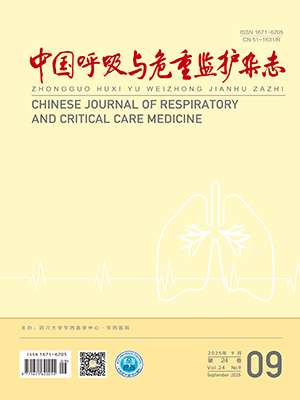| 1. |
Murray CJ,Lopez AD.Alternative projections of mortality and disability by cause 1990-2020:Global Burden of Disease Study. Lancet,1997,349:1498-1504.
|
| 2. |
Ng CS,Wells AU,Padley SP. A CT sign of chronic pulmonary arterial hypertension:the ratio of main pulmonary artery to aortic diameter. J Thorac Imaging,1999,14:270-278.
|
| 3. |
Iyer AS,Wells JM,Vishin S,et al. CT scan-measured pulmonary artery to aorta ratio and echocardiography for detecting pulmonary hypertension in severe COPD.Chest,2014,145:824-832.
|
| 4. |
高新海,徐仲卿,赵文穗. 血浆氨基末端脑钠肽水平与不同程度慢性阻塞性肺疾病肺动脉高压的相关性. 广东医学,2011,32:1150-1151.
|
| 5. |
王同生,毛毅敏,孙玉霞,等. 白介素-6 和内皮素-1 在慢性阻塞性肺疾病合并肺动脉高压患者中的表达. 实用医学杂志,2012,28:1977-1979.
|
| 6. |
Chaouat A,Savale L,Chouaid C,et al. Role for interleukin-6 in COPD-related pulmonary hypertension. Chest,2009,136:678-687.
|
| 7. |
MacIntyre N,Huang YC. Acute exacerbations and respiratory failure in chronic obstructive pulmonary disease. Proc Am Thorac Soc,2008,5:530-535.
|
| 8. |
荆志成. 2010 年中国肺高血压诊治指南.中国医学前沿杂志 (电子版),2011,3:62-81.
|
| 9. |
Wells JM,Washko GR,Han MK,et al. Pulmonary arterial enlargement and acute exacerbations of COPD. N Engl J Med,2012,367:913-921.
|
| 10. |
刘鹏,郭顺林,雷军强,等. 慢性阻塞性肺疾病相关肺动脉高压的多层螺旋CT评价. 中华结核和呼吸杂志,2012,35:264-268.
|
| 11. |
高靳,余建群,白红利,等. 慢性阻塞性肺部疾病病程与肺动脉直径变化关系的多层螺旋CT评价. 实用放射学杂志,2009,25:332-337.
|
| 12. |
Committee GS. Global strategy for the diagnosis,management,and prevention of chronic obstructive pulmonary disease (updated 2013). www.goldcopd.org.
|
| 13. |
Buist AS,McBurnie MA,Vollmer WM,et al. International variation in the prevalence of COPD (the BOLD Study):a population-based prevalence study.Lancet,2007,370:741-750.
|
| 14. |
Zhong N,Wang C,Yao W,et al. Prevalence of chronic obstructive pulmonary disease in China:a large,population-based survey. Am J Respir Crit Care Med,2007,176:753-760.
|
| 15. |
Jensen HH,Godtfredsen NS,Lange P,et al. Potential misclassification of causes of death from COPD. Eur Respir J,2006,28:781-785.
|
| 16. |
Sims MW,Margolis DJ,Localio AR,et al. Impact of pulmonary artery pressure on exercise function in severe COPD. Chest,2009,136:412-419.
|
| 17. |
Kessler R,Faller M,Fourgaut G,et al. Predictive factors of hospitalization for acute exacerbation in a series of 64 patients with chronic obstructive pulmonary disease. Am J Respir Crit Care Med,1999,159:158-164.
|
| 18. |
Parola D,Romani S,Petroianni A,et al. Treatment of acute exacerbations with non-invasive ventilation in chronic hypercapnic COPD patients with pulmonary hypertension. Eur Rev Med Pharmacol Sci,2012,16:183-191.
|
| 19. |
Minai OA,Chaouat A,Adnot S. Pulmonary hypertension in COPD:epidemiology,significance,and management pulmonary vascular disease:the global perspective. Chest,2010,137(6 Suppl):39S-51S.
|
| 20. |
Hoeper MM,Lee SH,Voswinckel R,et al. Complications of right heart catheterization procedures in patients with pulmonary hypertension in experienced centers. J Am Coll Cardiol,2006,48:2546-2552.
|
| 21. |
Hill NS,Klinger JR,Warburton RR,et al. Brain natriuretic peptide:possible role in the modulation of hypoxic pulmonary hypertension.Am J Physiol,1994,266:308-315.
|
| 22. |
Inoue Y,Kawayama T,Iwanaga T,et al. High plasma brain natriuretic peptide levels in stable COPD without pulmonary hypertension or cor pulmonale. Intern Med,2009,48:503-512.
|
| 23. |
Sormunen P,Kallio MJ,Kili IT,et al.C-reactive protein is useful in distinguishing Gram stain negative bacterial meningitis from viral meningitis in children.Pediater,1999,134:725-729.
|
| 24. |
王维,黄志峰,邓穗德.2 型糖尿病患者血清超敏C反应蛋白的表达特性.现代医院,2005,5:20-22.
|
| 25. |
赵宇.超敏C反应蛋白在慢性阻塞性肺疾病并发肺动脉高压中的意义.实用医技杂志,2008,15:2761-2763.
|
| 26. |
Humbert M,Monti G,Brenot F,et al.Increased interleukin-1 and interleukin-6 serum concentrations in severe primary pulmonary hypertension.Am J Respir Crit Care,1995,151:1628-1631.
|
| 27. |
Golembeski SM,West J,Tada Y,et al. Interleukin-6 causes mild pulmonary hypertension and augments hypoxia-induced pulmonary hypertension in mice. Chest,2005,128(6 Suppl):572S-573S.
|
| 28. |
Joppa P,Petrasiva D,Stancak B,et al. Systemic inflammation in patients with COPD and pulmonary hypertension. Chest,2006,130:326-333.
|
| 29. |
Guignabaert C,Raffestin B,Benferhat R,et al.Serotonin transporter inhibition prevents and reverses monocrotaline induced pulmonary hypertension in rats. Circulation,2005,111:2812-2819.
|




